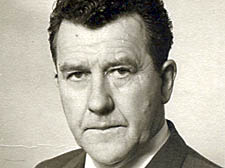|
|
 |
| |

John Murphy |
Founder of building empire dies
Rich List millionaire who hitch-hiked to London from Ireland in the 30s
A RECLUSIVE Irish millionaire who built up a construction empire from a goods yard in Kentish Town has died.
John Murphy, founder of the civil engineering company known by its ubiquitous dark green lorries, hitch-hiked from County Kerry to London in the 1930s and made a fortune in the building trade during the post-war years.
Mr Murphy, famously secretive about his personal life, is believed to have died at the age of 85, although some put it closer to 100.
From the J Murphy and Sons headquarters in Highgate Road – complete with hives of bees – Mr Murphy owned 18 companies across Britain with business interests stretching as far as Greece and the Middle East.
Michael Donaghue, who worked with Mr Murphy in the 1950s, said: “I worked with John when we were up in Highgate. We were doing civil engineering jobs at the time. I was a driver, but in those days you had to do more than drive.”
Mr Donaghue, now retired, said: “He was a very hard man to work for, and he was a hard character too. The firm was already pretty big by then, and well established. Even in the 50s I would say he was already a millionaire, or at least a very rich man.”
Mr Murphy was valued on The Sunday Times Rich List this year as worth £190million.
He apparently continued to visit the Kentish Town site, taking breakfast with the workers, despite his advancing years and his huge fortune.
Regarded as a philanthropist and pillar of the Irish community, Mr Murphy and his company were pursued by the Inland Revenue over tax evasion in the 1970s, specifically over the system of employment known as “the lump”, by which workers hired themselves out to the highest bidder.
The company was fined £750,000 and several employees jailed, though Mr Murphy was never charged. He continued undaunted, travelling frequently for business though never splashing out on the trappings of a millionaire lifestyle.
Company vice-chairman Caroline Murphy and managing director John Stack said in a statement: “Mr Murphy’s vision has been the driving force behind the development and continued success of the company where he maintained an active role up to very recently. His presence and contribution will be sadly missed by employees, business associates, family and friends.”
Early-morning pick-up points for ‘the green and the grey’
THE muddy lorries and vans parked in the street, while the “subbies” or “agents” responsible for them were recruiting labour, were once a feature of grim early mornings in Camden Town.
Each of the major firms had its pick-up point. For the Murphy brothers, this was near Peter’s Café in Camden Road, where often alongside their vans were battered coaches ready to take men to sites at Heathrow Airport or the Isle of Grain power station.
Their vehicles were distinctively painted. Those that were green were the vans of John Murphy, and those that were grey were of his brother, Joseph. Within the Irish community they soon become known as “the green and the grey”. The Green Murphy’s men tended to work at ground level or above, while those of Joe, the Grey Murphy, worked underground, often in cable-laying or tunnelling. Hence the colours.
John and Joe were part of a large family from near Caherciveen in County Kerry. John Murphy, disembarked from the boat at Holyhead just before the war. He was followed to England by his brother, who died a tax exile in Guernsey in 2000.
During the war, John was contracted to remove obstacles from the English Channel. After 10 years, he and Joe opened separate depots. “Big” John’s survives at Hillview House, off Highgate Road, in Kentish Town, where until late in his life he was one of the first to arrive each morning. He was often to be seen sweeping the yard, the sleeves of his ill-fitting suit contrasting with the workman’s hands with which he wielded the broom. Inside the office foyer were two beehives, a gift from a Kerry friend, which he kept there as a reminder of swarming industriousness.
Joe Murphy’s yard off Agar Grove was later to become part of the Maiden Lane estate.
A secretive man, John Murphy spent the last years of his life in Greenaway Gardens, Hampstead, where he lived with his second wife, who had been the nurse of his first in her illness. Dancing and golf were his pastimes. Occasionally he ventured to Mass, in particular to the Sacred Heart of Jesus Church in Quex Road, Kilburn.
He rarely flaunted his wealth. There were donations to charity and other philanthropic gestures, such as his involvement in the building of extensions to the London Irish Centre in Camden Square, which had accommodated in its hostels so many of the men who once worked for the family business.
GERRY HARRISON
|
 |
|
|
 |
| |
| |
|
 |
|